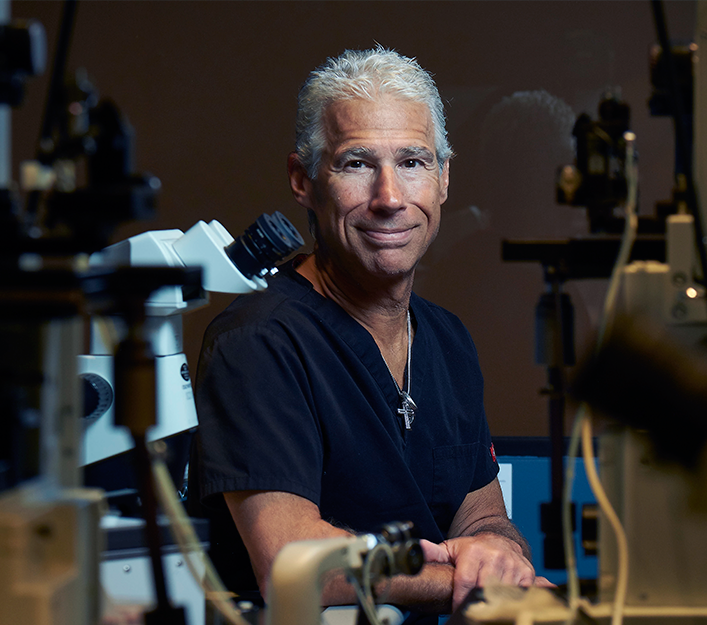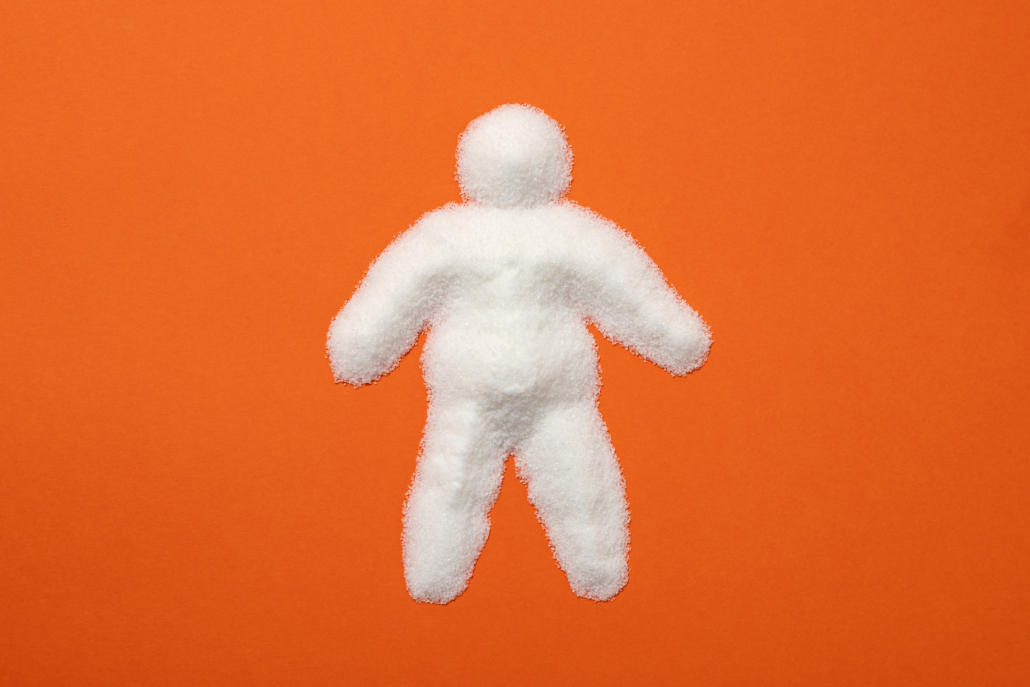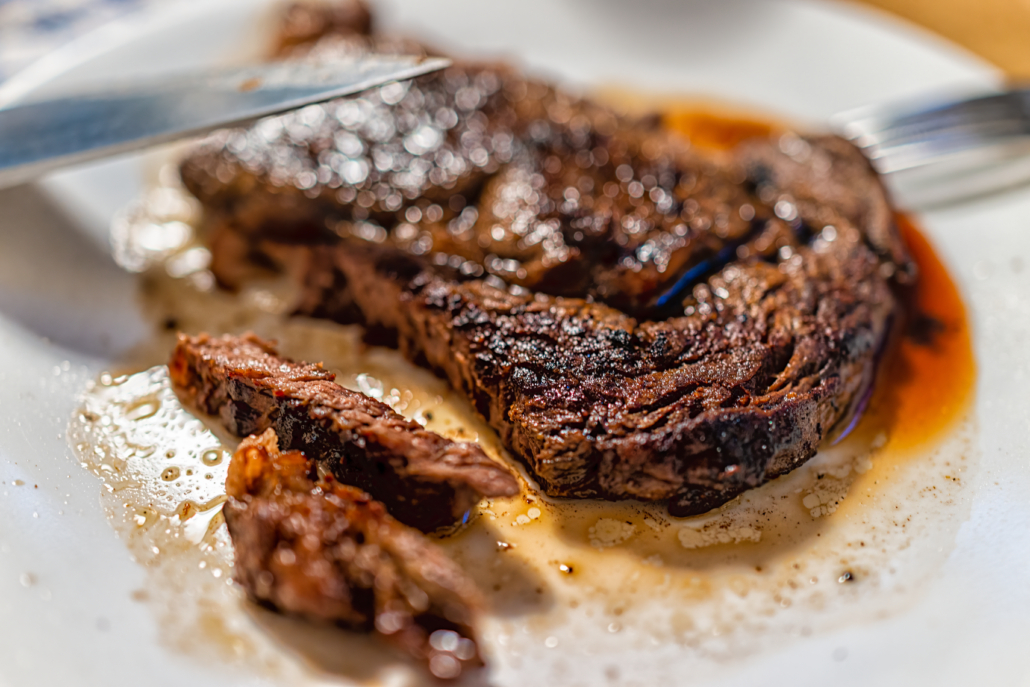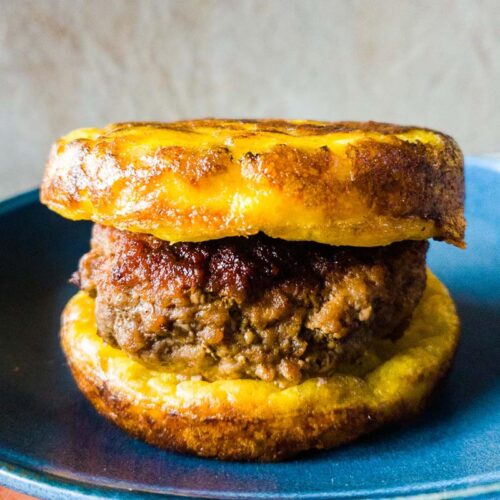We include products in articles we think are useful for our readers. If you buy products or services through links on our website, we may earn a small commission.
Types of Fat in Food: Everything you Need to Know
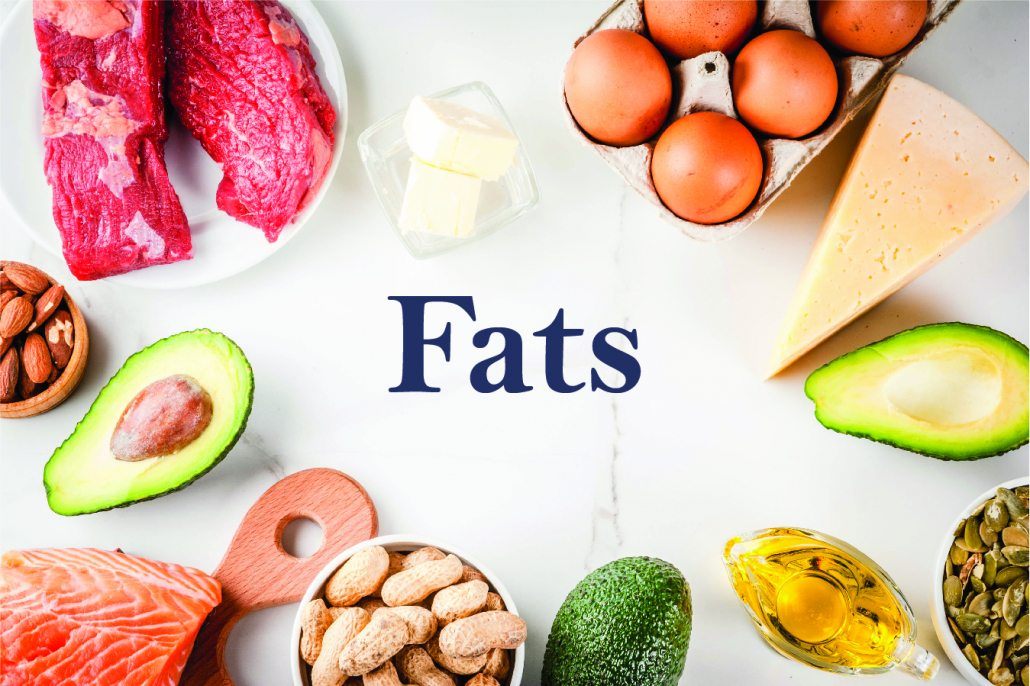
Table of Contents
- What is Fat?
- A Deeper Understanding of Fat
- Saturated Fats
- Unsaturated Fats
- Monounsaturated Fats
- Polyunsaturated Fats
- How are Fats Absorbed in the Body?
- Essential Fatty Acids
- What Are Omega-3 Fatty Acids?
- What are Omega-6 Fatty Acids?
- Is Fat Good or Bad?
- Benefits of Fat
- Bottom Line on the Types of Fat in Food
What is Fat?
The types of fat in our food comprise one of two essential macronutrients necessary for our health and survival. The only other essential macronutrient is protein.
In dietary terms, the word “essential” is very specific–it means our bodies can’t make it on thier own, so we have to get it through our diet.
From a scientific perspective, the various types of fat we need to eat are fatty acids that exist in three main classes:
- Triglycerides
- Phospholipids
- Cholesteryl esters
In each of these forms, the fats we get from food are essential sources of fuel and critical to the structure of nearly every cell in the body.
As an ultra-efficient source of energy, fat provides nine calories per gram versus the four calories per gram offered by protein and carbohydrates–the other two macronutrients we get in our diets.
A Deeper Understanding of Fat
To picture a fatty acid molecule, think of a capital E. The vertical part corresponds to the glycerol. The arms of the E are the fatty acids. They consist of chains of carbon and hydrogen atoms.
The fatty acids can have different lengths in various combinations. One arm may be a medium-chain fatty acid (6-10 carbons), with two others being long-chain fatty acids (greater than 12 carbons long).
Edible types of fat vary from oils to solids. The differences are driven by the chemical bonds between the carbon and hydrogen atoms that they’re made of.
You may remember from high school chemistry that atoms bind to one another by sharing electrons. Carbon atoms have 4 electrons to give while hydrogen atoms have one electron.
To completely bind a carbon atom, all four of the electrons available must be bound or “saturated” by either hydrogen or another carbon atom, as in the image below. C stands for Carbon, and H for hydrogen.

In contrast, this next image is a fatty acid in which most of the carbon (C) atoms have all four points connected to hydrogen (H) atoms, except for two in the middle.
These carbon atoms have a second connection to each other. That’s called a double bond and it leaves each of the involved carbon atoms with an “unsaturated” or loose electron (shown by the orange dot). This double bond situation is what separates unsaturated fatty acids from saturated ones.

Saturated Fats
Saturated fats are those in which all the carbon bonds are saturated, so there are no double bonds or loose electrons to react with other atoms.

Because of their straight shape, saturated fatty acids can pack closely together. This makes them usually solid at room temperature. They are chemically stable and less likely to go rancid when exposed to oxygen, heat, or light.
Butter, lard, and coconut oil are examples of saturated fats. Coconut oil is solid at room temperatures (about 72º F) so you may be wondering why it is called an oil. This oil melts at temperatures above 76º F, and since coconut is a tropical plant, the outside temperature where it is manufactured is usually warmer than that, hence the oil designation.
Unsaturated Fats
Unsaturated fatty acids have one or more double bonds and loose electrons. There are two major types of unsaturated fats:
- Monounsaturated (MUFA), meaning the fat molecules have one double carbon bond. Olive oil is an example of a fat high in monounsaturated fatty acids.
- Polyunsaturated (PUFA), meaning the fat has many double carbon bonds. Most vegetable and seed oils (canola, sunflower, cottonseed, soybean) are high in polyunsaturated fatty acids.
Because of the many double bonds, these types of fatty acids are “kinked” in shape and are liquid at room temperature.
Because of their chemical volatility, these unsaturated oils are prone to rancidity and oxidation. This chemical volatility is an important point, as rancid (oxidized) PUFA are strongly associated with cardiovascular disease.
Monounsaturated Fats
The American Heart Association recommends monounsaturated fats because epidemiological research indicates that consuming these fats reduces risk factors for heart disease. But the controlled research evidence for this is inconclusive.
Olive oil, avocado oil, and canola oil are all high in monounsaturated fatty acids. Olive oil is the most well-known monounsaturated fat. Thanks to epidemiological data on the Mediterranean diet, olive oil has attained an almost holy status as a healthy food. There is some corroborating controlled research, but it is by no means conclusive. Olive Oil Matter?”/]
In addition, all olive oils are not equal. There are differences in type (virgin, extra-virgin, light) and in quality. Some manufacturers dilute their olive oil with other vegetable oils to save money. This practice has resulted in the development of authenticity guidelines and oil analysis to ensure purity.
Polyunsaturated Fats
There are many kinds of commercially refined vegetable and seed oils, including:
- canola or rapeseed oil
- soybean oil
- corn oil
- sunflower oil
- safflower oil
- peanut oil
These refined cooking oils are made through a highly intensive mechanical and chemical process which uses heat and pressure to extract the oil from the source.
This process removes pesticide residues and introduces solvents such as hexane , which are then cleaned out of the oil using diatomaceous earth.
The entire process includes degumming, treating the oil with lye, bleaching it, and then deodorizing it. Does this sound like food to you?
Trans Fats
Trans fats are a type of fat created when a liquid PUFA such as soybean oil is subjected to “hydrogenation.” This is a process in which hydrogen is forced into the oil to saturate the double carbon bonds, effectively causing the oil to become partially solid.
The “trans” name comes from the different way the hydrogen-carbon bonds are oriented chemically opposite, in comparison to a naturally occurring cis bond, as shown below.
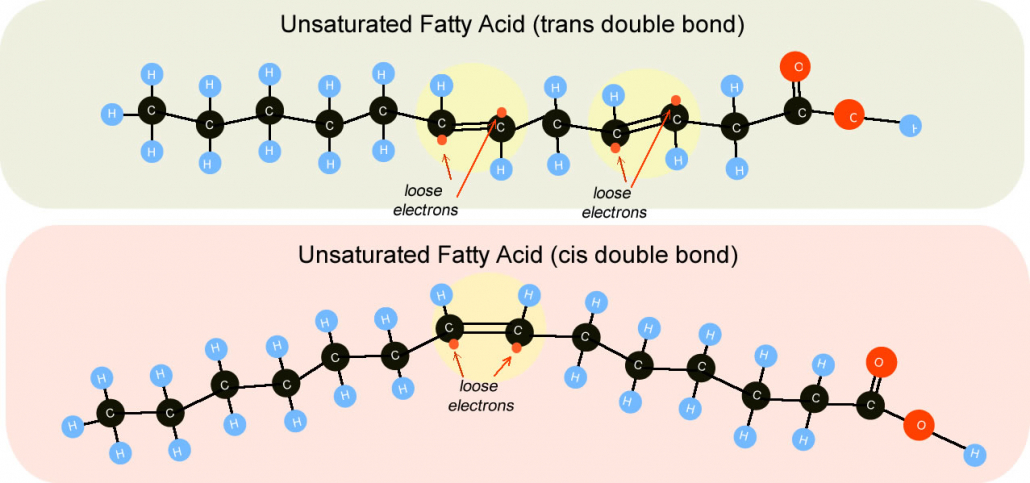
Examples of foods containing trans fats include shortening and margarine made from various hydrogenated seed oils, and processed or fast foods made using these products.
The FDA identifies trans fats as unsafe because studies have shown that consumption of trans fats causes distortions in cellular membranes and increases LDL (bad) cholesterol without a simultaneous rise in HDL (good) cholesterol. This results in worsening heart disease risks.
How are Fats Absorbed in the Body?
Most people know that water and fats don’t mix. This chemical reality poses a special problem for your digestive system for two reasons:
- The protein-based enzymes (lipases) the body uses to digest fat molecules work best in water, which repels fat.
- Human lymph and blood are water-based liquids, so the digested fats will have to be put into a form that can ride through the water.
Emulsification
To solve the first enzyme issue, the digestive system utilizes emulsification. This happens in your digestive tract. The churning action of digestion breaks up consumed fat molecules into smaller droplets, suspending them in the surrounding liquid and providing more surface area on which the enzymes can work.
Although fat digestion starts in the mouth and stomach, most of the work is done in the duodenum or upper intestine. There, bile from the gallbladder further emulsifies the fats. Then pancreatic lipase splits the glycerol and fatty acids in various ways to prepare them for transport into the bloodstream.
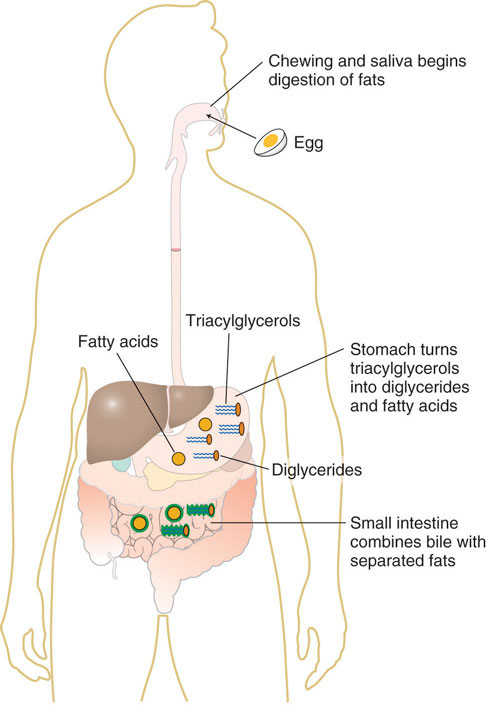
Emulsification of fat in the human body. Source: med.libretexts.org
The triacylglycerol molecules may be split into a diacylglycerol (DAG – glycerol backbone with two fatty acids attached) or a monoacylglycerol (MAG – glycerol backbone with one fatty acid attached).
Once created, the DAG, MAG and free long-chain fatty acids are transported into or absorbed by specialized cells called enterocytes in the wall of your digestive tract.
Within the enterocyte cell, the glycerol and long-chain fatty acids are “re-esterified” or reformed back into TAG and shoved into a chylomicron, one of the many fat-transporting lipoproteins the body makes. Picture a sphere with a center of fat and an outer membrane of molecules that are water-friendly.
The chylomicron is released into the watery lymph system and enters into the bloodstream via the left subclavian vein.
The utility of this lymph system shortcut is that it allows the chylomicron to skirt the liver and go directly to the bloodstream. There it can then drop off its TAG core directly to muscles for use as energy or to fat cells for storage.
Digestion of Medium-Chain Fatty Acids (MCTs)
You may have noted that the process described above takes care of long-chain fatty acids. But what about medium-chain fatty acids, such as those in coconut oil?
Medium-chain triglycerides (MCTs) are not packaged into chylomicrons. Instead, these fatty acids pass directly from the enterocyte into the portal vein where they are bound to a protein called albumin and transported directly to the liver.
In the liver, MCTs can be used immediately for energy creation, or they can also be packaged into very low-density lipids for transport to storage. If ketogenesis is the dominant energy system within the body, MCTs can also be used in ketone production.
Essential Fatty Acids
Essential fatty acids (EFA) are PUFA that human bodies cannot create internally, but which are required for good health. This means you have to get this type of fatty acids from the food you eat.
There are two different types of EFA, and they work in opposition to each other:
- Omega-3 fatty acids
- Omega-6 fatty acids
The chart below shows some of the effects of these fatty acids in the body, and each type is discussed in more detail in the following sections.
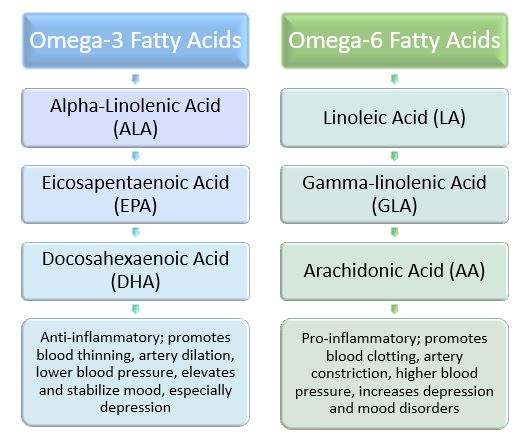
What Are Omega-3 Fatty Acids?
Omega-3 fatty acids are a type of essential polyunsaturated fatty acids that are important precursors for anti-inflammatory biochemical pathways in our bodies.
When you consume omega-3s in sufficient amounts, they balance and regulate your body’s pro-inflammatory pathways. A deficiency or imbalance of omega-3 fats will result in a variety of health problems including neurological damage[12] and psychiatric disorders such as depression.
Rich food sources of omega-3 fatty acids include fish and shellfish, especially oily fish such as salmon and sardines.
The three major omega-3 fatty acids are:
- Alpha-Linolenic Acid (ALA)
- Eicosapentaenoic Acid (EPA)
- Docosahexaenoic Acid (DHA)
What are ALA, EPA and DHA?
Alpha-Linolenic (ALA) is a plant-based long-chain PUFA and the chemical parent molecule for EPA and DHA, two important fatty acids humans require for good health.
Small animals can easily convert ALA to EPA and DHA, but this is not the case for humans. This is a good reason for people who follow vegetarian and vegan diets to supplement regularly with preformed EPA and DHA in the form of an algal or krill oil.
More on EPA and DHA
Although epidemiological studies have linked both EPA and DHA to good cardiovascular health, controlled study data has been weaker.
There is some evidence that small amounts of EPA and DHA do improve cardiovascular health markers by lowering blood pressure, improving heart rate and rate variability, reducing platelet aggregation, and raising both HDL and LDL cholesterol.
However, there have also been studies showing that the consumption of high amounts of fish oil rich in EPA and DHA can elevate blood sugar and aggravate diabetes.
Stronger controlled studies on EPA have found that this PUFA is important in the regulation of mood, but some researchers think its most important job is acting as a parent molecule for DHA, a fatty acid that has profound effects on brain growth and function.
DHA is one of the most prevalent fatty acids in the human brain and is particularly important in brain development in children, and visual and neurological health in adults.
Good Sources of Omega-3 Fatty Acids
Seafood, especially oily fish such as mackerel, herring, sardines, salmon, and shellfish such as oysters are the best food sources of the types of fat called EPA and DHA.
Plant foods such as walnuts, flaxseed, and chia seeds are good sources of ALA, but as mentioned, the human body can’t convert ALA to EPA or DHA in any appreciable amounts.
Studies have shown that high ALA intake does not translate to large increases in EPA or DHA within the body.
What are Omega-6 Fatty Acids?
Omega-6 fatty acids are a class of polyunsaturated fatty acids important for pro-inflammatory responses and a healthy immune system. A deficiency of omega-6 fats can result in skin disease and a decline in nerve cell function.
The three major omega-6 fatty acids include:
- Linoleic Acid (LA)
- Gamma-linolenic Acid (GLA)
- Arachidonic Acid (AA)
What is Linoleic Acid (LA)
Linoleic Acid is a plant-based long-chain, essential polyunsaturated fatty acid. It is the chemical parent molecule for gamma-linolenic acid and arachidonic acid.
Linoleic Acid is also the most common and highly consumed fatty acid in the human diet.
This is not a good thing, given these types of fatty acids are pro-inflammatory. Typical intakes of this nutrient on a standard American diet are high because most processed and fast foods are made with hydrogenated vegetable and seed oils rich in LA.
Sources of Omega-6s
Soybean oil is the most likely source of Omega-6 PUFA for many people, accounting for about 43% of intake. Other vegetable and seed oils, as well as nuts, seeds, meat and eggs are good sources as well.
An astonishing fact to note is that from 1909 to 1999, Americans increased their per capita consumption of vegetable and seed oils by 2000 percent, and the consumption of soybean oil over 115,000 percent.
This is disturbing, especially since the latest USDA report shows that 94 percent of the commercial soybean crop is genetically modified.
The Omega Ratio Problem: Are You Off-balance?
There is no upper limit set by nutritional experts for Omega-6 PUFA consumption in terms of safety. However, there is great concern over the health effects associated with the amounts of Omega-6 consumption when compared to Omega-3 consumption in the standard American diet.
The ratio of the consumption of these two types of fat should be about 1:1 for good health.
But since American diets are high in Omega-6 PUFA while at the same time, low in foods that provide Omega-3s, our consumption ratios are heavily skewed toward Omega-6 fatty acids such as LA and AA.
Arachidonic acid is the precursor molecule for a biochemical pathway that creates over 20 pro-inflammatory eicosanoids–powerful signaling molecules in the human body.
This is why overeating omega-6 PUFA ramps up body inflammation, and without a balancing influence from Omega-3 PUFA, this sets the stage for inflammation-related disease.
Is Fat Good or Bad?
The idea that “fat is bad” is entrenched in our culture. We think of fat as something to avoid, both in our food and on our bodies.
We think that the less we have of it the healthier we are. When we have too much of it, we feel ugly and unhappy. But the truth is, fat is good for us, and it is incredibly important to human life and health.
Is saturated fat good or bad?
Saturated fat and cholesterol are types of fat that have gotten a bad reputation over the past 50 years, and it was undeserved.
The misinformation originated with an American physiologist named Ancel Keyes. In the 1950s, using cherry-picked evidence from his Seven Countries study, Keyes managed to convince the mainstream media and the federal government that heart disease was caused by saturated fat and cholesterol consumption.
This was during a time when middle-aged men were dying from heart disease in alarming numbers and scientists were frantically trying to figure out why.
In this climate Keys’ “diet-heart hypothesis” quickly gained traction. The advice to eat less fat and more carbohydrate became pervasive.
However, with our current and more sophisticated understanding of metabolic processes, Keys’ findings are being revised and called into question.
And despite the culture-wide adoption of Keys’ assertions, today, heart disease is still the number one cause of death in the US.
Diabetes and other metabolic disease rates have skyrocketed, as you can see in the CDC’s graph below.
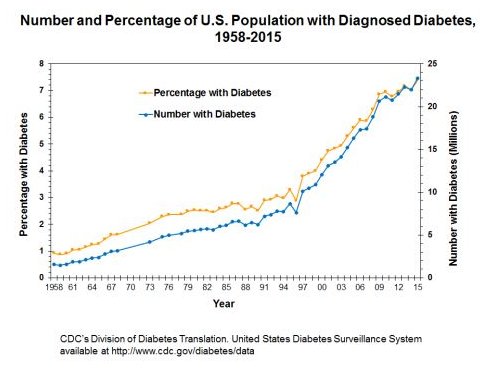
A recent analysis sums up the evidence on saturated fat and heart disease . Consuming saturated fat is not harmful to human health. In contrast, replacing dietary saturated fat with carbohydrate or polyunsaturated fat as advised by fat phobics like Keyes, does little to improve human health.
While for people with metabolic diseases such as diabetes, a low-carbohydrate, higher fat diet improves health.
Benefits of Fat
Fat is Energy
Fat is a major source of energy for most animals. It weighs less than muscle so it’s easier to store and carry, and it is way more energy-dense.
With normal fat stores, human beings can easily survive for several months without eating. With extra fat stores, survival time can be extended many months beyond that.
It’s interesting to note that the human body can only store about a short day’s energy in the form of carbohydrates. This biochemical fact supports the idea that we survived as a species because we can store and burn fat.
Fat Provides Protection
Without these types of fat, you would have no padding around your bones. If you ever sat on a hard surface for a long time, you know how uncomfortable that is, and that’s with padding! And without fat to protect your internal organs, a simple fall could cause serious internal trauma.
Fats Lubricate our Moving Parts
Fats are important ingredients in keeping our eyes, joints, skin, mucosal membranes, and other body tissues lubricated and functional.
Types of Fat for Brain Health
Without different types of fats such as cholesterol and DHA, your brain would not work. The human brain is over 60% fat by weight, and a lack of cholesterol can negatively affect emotional health.
Temperature Regulation
Without fat as an insulation layer and heat source, you would freeze to death much more quickly in cold weather.
Cellular Membranes and Hormone Regulation
Fat is necessary for the creation and control of cellular membranes and the production of:
- several important cellular signaling hormones
- steroid hormones
- eicosanoids
- growth factors and immune system cells for regulating and protecting various body systems, including the reproduction system.
Women with super-low body fat lose the ability to have children. Women of reproductive age need at least 20.5% body fat to menstruate and get pregnant.
Vitamin Transport
Fat-soluble vitamins A, D, E and K can’t be absorbed or utilized within the digestive tract without fat and fat-based molecules such as bile.
Bottom Line on the Types of Fat in Food
The bottom line on all types of dietary fats is that natural saturated and unsaturated fats are better for you than industrial vegetable and seed oils. The tips below will help you choose the right fats for good health:
- Make sure you focus on foods containing omega-3 fatty acids and limit your omega-6 containing foods to keep these two essential fats in balance.
- Include healthy animal fats from beef, fish, shellfish and poultry in your daily diet. These are natural sources of essential fatty acids as well as other healthy nutrients.
- If you are able, buy grass fed meats and wild caught seafood. These will have a healthier omega 3 to omega 6 ratio.
- Don’t be afraid of saturated fats. Enjoy pastured butter and the fat on your steak or chop!
- Avoid hydrogenated vegetable and seed oils and food products made with them. They are high in trans fats. Remember that most fried, processed, and fast food is made with these fats.
- If you choose to eat a vegan diet (or vegan keto diet), be sure to supplement with algal oils or similar sources of DHA and EPA.











